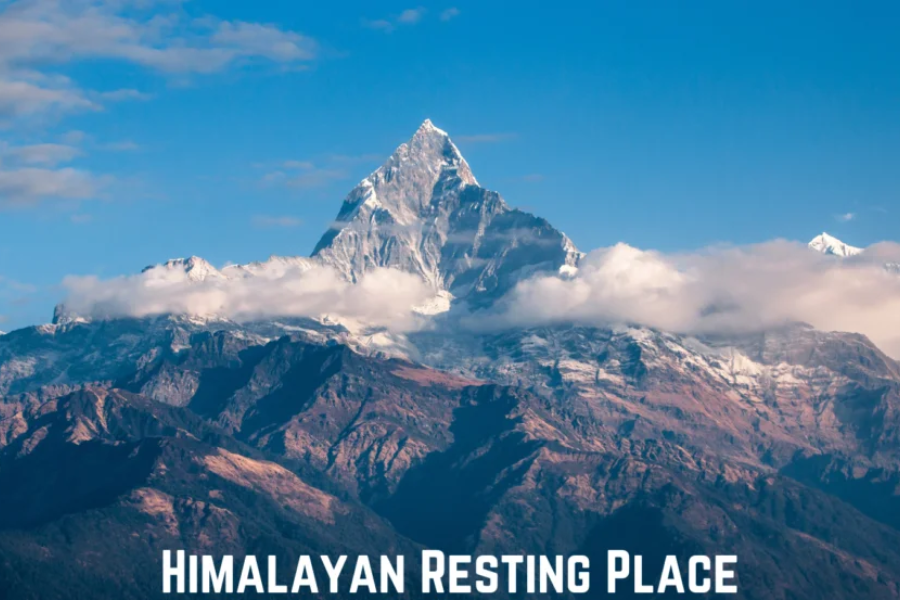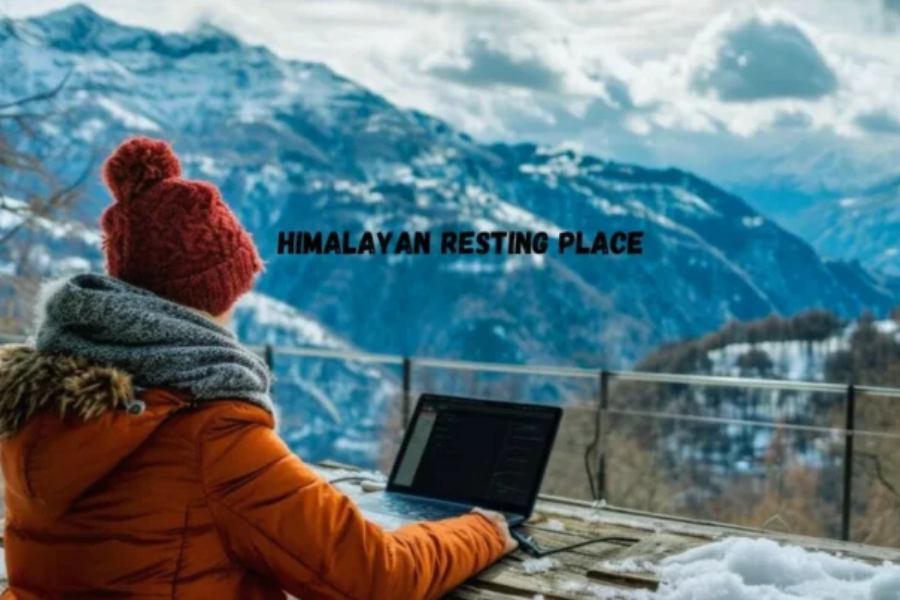The Himalayas, famously known as the “abode of snow,” majestically span five countries: Bhutan, China, India, Nepal, and Pakistan. These mountains are much more than just a series of high peaks; they are a vast and varied landscape that has captivated explorers, pilgrims, and adventurers for generations. Central to this breathtaking range is the idea of the Himalayan resting place. This concept embodies both a tangible and symbolic refuge, providing peace, isolation, and a profound connection to nature and spirituality. This article delves into the enchanting appeal and significance of the Himalayan resting place, examining its cultural, spiritual, and ecological importance.
The Concept Of The Himalayan Resting Place
A Sanctuary for the Soul
The concept of a “Himalayan resting place” extends far beyond a mere physical location. It symbolizes a sanctuary where individuals can find peace and spiritual rejuvenation amidst the majestic mountains. These places are often remote and challenging to reach, embodying the belief that true tranquility and enlightenment require a journey—both physical and spiritual.
Historical Significance
Throughout history, the Himalayas have been a sought-after destination for pilgrims in search of enlightenment. The arduous trek to these resting places often involves navigating difficult terrains, representing the inner journey of overcoming personal challenges to achieve higher consciousness. Many of these sites are steeped in legends and myths, enhancing their mystical charm and allure.
Modern Pilgrimages
In today’s world, the idea of the Himalayan resting place has expanded to include not only spiritual seekers but also adventurers and tourists aiming to escape the pressures of modern life. These sanctuaries offer a unique combination of serenity and adventure, drawing a diverse group of people who seek to refresh their minds and bodies in the pure, untouched mountain environment. Whether it’s through meditation, trekking, or simply absorbing the natural beauty, visitors find a profound sense of renewal in these hallowed places.
The Himalayas: A Peaceful Haven For The Departed

The Himalayan Mountains: A Bridge Between Realms
The Himalayan mountains, with their serene beauty and isolated grandeur, are often seen as a bridge between the earthly realm and the spiritual world. This unique characteristic makes them an ideal resting place for those who have passed on, providing a sacred environment for the soul’s journey after death.
A Cultural Mosaic of Death Rituals
Within the diverse communities that inhabit the Himalayas, death is viewed not as an end but as an important transition. Each culture has developed its own distinctive rituals to honor the deceased and guide them to the afterlife, reflecting a rich tapestry of beliefs and practices.
The Tibetan Sky Burial
One of the most renowned Himalayan burial practices is the Tibetan sky burial. This ritual reflects the Tibetan Buddhist philosophy of impermanence and interconnectedness. During this ceremony, the body of the deceased is offered to vultures, which are considered to be dakini or angels. By consuming the remains, these birds help return the body to the cycle of life, emphasizing the belief in the continuity of existence.
The Final Journey Across the Mountains
In some Himalayan communities, the deceased are carried across the mountains to reach a special burial site, often a secluded cave or area where the body can rest undisturbed. This pilgrimage-like journey symbolizes the soul’s ascent to higher realms and is undertaken with great respect and care. The process of transporting the body through the rugged terrain is seen as a final act of devotion, representing the soul’s passage from the physical world to a spiritual plane.
Expanding the Legacy
The practices surrounding death in the Himalayas are not only rituals but also a way of preserving cultural identity and continuity. These traditions, passed down through generations, provide a sense of belonging and understanding of the life cycle. As the modern world encroaches upon these ancient practices, there is a growing effort within these communities to preserve and respect their unique cultural heritage.
In conclusion, the Himalayan resting places serve as more than mere burial sites. They represent a profound connection between the physical and spiritual, the past and the present. Through their unique death rituals, the Himalayan cultures offer a compelling glimpse into the ways they honor life, death, and the journey beyond.
The Himalayas: A Tapestry Of Culture And Nature
A Natural Marvel
The Himalayas are home to some of the world’s highest peaks, including the majestic Mount Everest, which soars to an awe-inspiring 8,848 meters (29,029 feet). This impressive mountain range acts as a natural barrier that profoundly influences the climate, culture, and biodiversity of the surrounding regions. From the lush valleys of Bhutan to the arid plateaus of Tibet, the Himalayas encompass a vast array of ecosystems that support a rich and diverse tapestry of life.
A Cultural Melting Pot
Culturally, the Himalayas are equally diverse. They serve as a crucible of languages, traditions, and religions. The region is dotted with Buddhist monasteries that cling precariously to cliffs in Bhutan and Tibet, as well as Hindu temples nestled within the Indian Himalayas. These mountains stand as a testament to human resilience and spirituality. Each community within the Himalayas has developed its own unique way of life, intricately intertwined with the natural rhythms and challenges of the mountainous environment.
Preserving A Unique Heritage
As globalization and climate change impact the region, there is a growing movement to preserve the unique cultural and natural heritage of the Himalayas. Efforts are being made to protect endangered species, maintain traditional knowledge, and support sustainable tourism practices. By doing so, the people of the Himalayas aim to ensure that their rich legacy endures for future generations.
In conclusion, the Himalayas are more than just a range of mountains. They are a natural marvel and a cultural melting pot, embodying the beauty and complexity of the world’s highest peaks. Through their diverse ecosystems and vibrant cultures, the Himalayas continue to inspire awe and reverence, standing as a symbol of both the natural world’s grandeur and the enduring spirit of its inhabitants.
The Evolution Of Himalayan Resting Sites

Balancing Tourism and Conservation
As the Himalayas gain popularity as a travel destination, finding a balance between tourism and conservation becomes crucial. Eco-friendly accommodations, comprehensive waste management programs, and community-based tourism projects are essential in reducing environmental impact and fostering sustainable development. Promoting responsible tourism is key to protecting the pristine beauty and ecological diversity of the Himalayan resting places for future generations.
Cultural Preservation
Amidst the rise in tourism, preserving the rich cultural heritage of Himalayan communities is equally important. The influx of visitors can lead to cultural dilution and commercialization. Supporting local traditions, craftsmanship, and indigenous languages is vital to maintaining the unique identity of these regions. By nurturing cultural authenticity, Himalayan resting places can retain their spiritual and cultural significance, offering visitors an enriching experience rooted in tradition and history.
The Role of Technology
Technological advancements are transforming access to remote Himalayan resting places by improving infrastructure and communication networks. While these innovations enhance connectivity and convenience for visitors, it is crucial to ensure they complement rather than compromise the natural and cultural integrity of these sacred sites. Responsible integration of technology can empower local communities, providing economic opportunities while preserving the pristine environment and cultural heritage that define Himalayan resting places.
Expanding the Efforts
To further protect the delicate balance between tourism and conservation, it is important to involve local communities in decision-making processes. Educating tourists about sustainable practices and respecting local customs can also contribute to the preservation of the Himalayas. Encouraging community-based tourism allows locals to benefit economically while ensuring that tourism development aligns with their needs and values.
Enhancing Visitor Experiences
Sustainable tourism initiatives not only protect the environment but also enhance visitor experiences. Eco-tourism packages that include guided tours by local experts can provide deeper insights into the region’s ecology and culture. Investing in sustainable infrastructure, such as solar-powered facilities and low-impact hiking trails, can make the Himalayas more accessible while preserving their natural beauty.
In conclusion, the Himalayas are a treasure trove of natural beauty and cultural richness. Balancing tourism with conservation and cultural preservation is essential to safeguarding this heritage. By promoting responsible tourism, supporting local traditions, and integrating technology thoughtfully, we can ensure that the Himalayan resting places remain a source of inspiration and wonder for generations to come.
Notable Himalayan Resting Places
Lumbini, Nepal
Lumbini, the birthplace of Siddhartha Gautama, who later became known as Buddha, stands as one of the most significant spiritual resting places in the Himalayas. Nestled in the Terai plains of Nepal, this UNESCO World Heritage site draws thousands of pilgrims annually. The serene Maya Devi Temple, marking the exact spot where Buddha was born, is surrounded by tranquil gardens and monasteries constructed by various Buddhist nations, offering a peaceful retreat for contemplation and prayer.
Rishikesh, India
Rishikesh, located on the banks of the sacred Ganges River in Uttarakhand, India, is renowned as the “Yoga Capital of the World.” This vibrant town is a haven for those seeking spiritual growth and physical well-being through yoga and meditation. The surrounding hills and forests are dotted with retreats and ashrams, providing visitors with opportunities to immerse themselves in practices that promote inner peace and mindfulness. The town’s spiritual ambiance is enhanced by the evening Ganga Aarti, a devotional ritual by the river that captivates both locals and visitors.
Paro Taktsang, Bhutan
Paro Taktsang, also known as the Tiger’s Nest Monastery, is one of Bhutan’s most iconic and sacred sites. Perched on a cliff 900 meters above the Paro Valley, it is believed to be the meditation site of Guru Rinpoche, the founder of Tibetan Buddhism, in the 8th century. The journey to this monastery is a pilgrimage in itself, involving a steep and challenging climb. However, the trek rewards visitors with breathtaking views and a profound sense of serenity, making the effort well worth it. The monastery’s remote location and stunning architecture add to its mystical allure.
Dharamsala, India
Dharamsala, situated in Himachal Pradesh, India, is renowned as the residence of the Dalai Lama and the headquarters of the Tibetan government-in-exile. This town is a prominent center for Tibetan Buddhism and attracts a large number of spiritual seekers and tourists. Dharamsala offers numerous meditation centers and monasteries where visitors can experience the peaceful ambiance of Tibetan spirituality against the stunning backdrop of the Dhauladhar mountain range. The town is also known for its vibrant Tibetan culture, reflected in its markets, cuisine, and festivals.
Testimonials from The Tired And Travel-Weary

Still unsure? Here are a few testimonials from weary travelers who have experienced the magic of the Himalayan Resting Place firsthand:
Traveler Testimonials
“I’ve traveled the world in search of the perfect place to rest my head, and nothing comes close to the serenity of the Himalayan Resting Place. It’s like stepping into another world entirely. The peace and calm here are beyond anything I’ve ever experienced.”
“I’ll admit, I was skeptical at first. But from the moment I arrived, I knew I had found something truly special. The tranquility of this place is unlike anything I’ve ever known. The natural beauty and the spiritual atmosphere create a unique experience that’s hard to put into words.”
“If you’re looking for a place to escape the stresses of modern life, look no further than the Himalayan Resting Place.The combination of stunning landscapes, peaceful surroundings, and rich cultural heritage make it an unforgettable destination.”
The Journey To The Himalayan Resting Places
Physical Challenges
Reaching the Himalayan resting places often requires traversing rugged terrains, crossing high mountain passes, and enduring unpredictable weather conditions. This journey is a true test of endurance and resilience, mirroring the inner challenges one must overcome to achieve a state of inner peace and enlightenment.
Spiritual and Emotional Transformation
As travelers navigate the mountain paths, they often confront their own limitations and fears. The majesty and isolation of the Himalayas create an ideal setting for introspection and self-discovery. Upon reaching these resting places, the sense of achievement is profound, often accompanied by a deep feeling of spiritual awakening and renewal. The journey, with its physical and emotional demands, offers a unique opportunity for personal growth and enlightenment.
Ecological Impact
The influx of visitors to these sacred sites brings economic benefits to local communities, but it also poses a threat to the fragile Himalayan ecosystem. Sustainable tourism practices are essential to preserving the natural beauty and cultural heritage of these resting places.Efforts currently strive to balance tourism with conservation, aiming to ensure that these sanctuaries remain unspoiled for future generations. Initiatives such as eco-friendly accommodations, waste management programs, and community-based tourism projects are crucial in mitigating environmental impact and promoting sustainable development.
The Challenges Faced By Remote Communities
The continuity of traditional burial practices faces significant challenges due to accessibility and the pressures of modern life. As urbanization and globalization reshape our world, younger generations often move away from their ancestral homes in pursuit of education, career opportunities, and a different lifestyle. This physical distance can result in a gradual loss of intimate knowledge and customs passed down through generations.
Migration to urban areas not only separates individuals from their traditional practices but also exposes them to diverse cultures and modern lifestyles, which can weaken their connection to ancestral rituals. The fast-paced nature of contemporary life, focused on convenience and efficiency, often leaves little room for the elaborate and time-consuming rituals associated with traditional burials.
Changing societal values and the influence of technology further contribute to a shift in priorities. The younger generation, immersed in a digitally-driven environment, may prioritize immediate needs and practical solutions over long-standing traditions that demand significant time and resources.
Economic pressures also play a crucial role. The costs associated with traditional burial practices, including elaborate ceremonies and specific rites, can be prohibitive. Many young people facing financial constraints may opt for simpler and more cost-effective alternatives like cremation or eco-friendly burials.
In summary, the combination of physical displacement, evolving cultural dynamics, and economic factors presents a formidable challenge to preserving traditional burial practices. Without deliberate efforts to bridge these gaps and uphold cultural heritage, the rich tapestry of ancestral customs risks fading amid the unstoppable march of modernity.
Future Of Himalayan Resting Places
Balancing Tourism and Conservation
The Himalayas are increasingly becoming a popular destination for travelers, highlighting the need for a delicate equilibrium between tourism and conservation. Initiatives like eco-friendly lodging, waste management schemes, and community-driven tourism projects are pivotal in minimizing environmental impact and fostering sustainable growth.
Preserving Cultural Heritage
Protecting the cultural legacy of Himalayan communities is equally critical as tourism expands. There is a concern that increased visitor numbers could erode local traditions. Supporting indigenous crafts, languages, and customs is crucial for preserving the distinct identity of these regions and ensuring that Himalayan resting places retain their cultural and spiritual significance.
The Role of Technology
Technological advancements are improving accessibility to these remote resting places. Enhanced infrastructure and communication networks are enriching visitor experiences and providing economic opportunities for local residents through tourism. However, it’s essential to manage these advancements carefully to prevent them from compromising the natural and cultural sanctity of these sacred sites.
FAQs
Q. Why is balancing tourism and conservation important in the Himalayas?
Balancing tourism and conservation is crucial in the Himalayas to protect its fragile ecosystems and preserve the cultural heritage of local communities amidst increasing visitor numbers.
Q. What are some initiatives aimed at minimizing environmental impact?
Initiatives include promoting eco-friendly accommodations, implementing effective waste management programs, and supporting community-based tourism projects that benefit local populations.
Q. How does tourism impact cultural preservation in the Himalayas?
Tourism can pose a risk to cultural erosion by exposing local traditions to outside influences. Efforts to support indigenous crafts, languages, and customs are essential for maintaining cultural authenticity.
Q. What role does technology play in tourism development in remote areas?
Technology improves accessibility and enhances visitor experiences in remote Himalayan regions. It’s important to manage it carefully so that we don’t compromise the natural and cultural integrity of these sacred sites.
Conclusion
The Himalayas stand as a beacon of natural beauty and cultural richness, attracting travelers from around the globe. As tourism in the region continues to grow, it is imperative to strike a balance that ensures the preservation of its unique environment and heritage. By implementing sustainable practices, supporting local communities, and leveraging technology responsibly, we can safeguard the Himalayan resting places for future generations to enjoy. With concerted efforts, we can ensure that this majestic mountain range remains a sanctuary of peace, spirituality, and ecological diversity for years to come.




